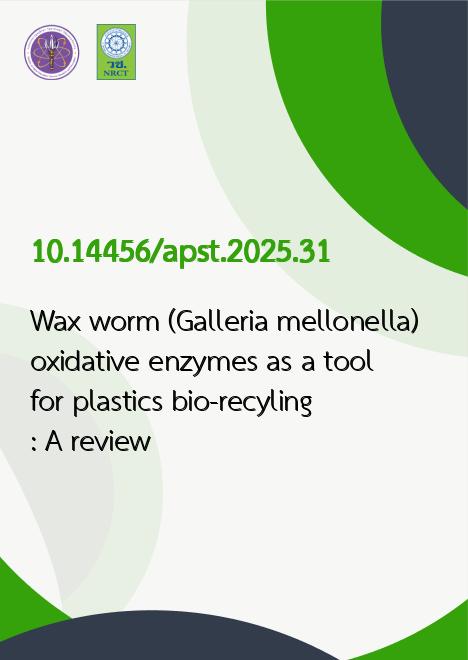
|
Wax worm (Galleria mellonella) oxidative enzymes as a tool for plastics bio-recyling: A review |
|---|---|
| รหัสดีโอไอ | |
| Creator | Kingsley E. Nwagu |
| Title | Wax worm (Galleria mellonella) oxidative enzymes as a tool for plastics bio-recyling: A review |
| Contributor | Adaugo G. Ibeh, Fredrick O. Okpaga, Mercy Nwaobia, Evelyn N. Enwere, Chidozie D. Udechukwu |
| Publisher | Khon Kaen University, Thailand |
| Publication Year | 2568 |
| Journal Title | Asia-Pacific Journal of Science and Technology |
| Journal Vol. | 30 |
| Journal No. | 2 |
| Page no. | 16 (9 pages) |
| Keyword | Bio-recycling, Economic viability, Environmental impact, Plastic pollution, Wax worm |
| URL Website | https://apst.kku.ac.th/ |
| Website title | https://apst.kku.ac.th/wax-worm-galleria-mellonella-oxidative-enzymes-as-a-tool-for-plastics-bio-recyling-a-review/ |
| ISSN | 2539-6293 |
| Abstract | Plastic pollution has become a pressing global challenge, with the widespread accumulation of plastic waste in landfills, oceans, and ecosystems. Conventional plastic recycling methods face limitations and challenges, including sorting difficulties, contamination issues, and down-cycling of plastic materials. In response, the concept of bio-recycling, which involves the use of biological agents to break down plastic materials, has emerged as a potential solution. Wax worm bio-recycling offers significant environmental benefits by reducing plastic waste and minimizing pollution. It has the potential to divert plastic waste from landfills and incineration facilities, thereby reducing the environmental burden associated with plastic disposal. By breaking down plastic materials into biodegradable fragments, wax worm bio-recycling helps mitigate plastic pollution in landfills, oceans, and ecosystems. Furthermore, it aligns with the principles of a circular economy, promoting the effective recycling and reuse of plastics. The economic viability and market opportunities for wax worm bio-recycling technologies are promising. Ongoing research focuses on optimizing enzyme performance, improving scalability, and developing industrial applications. Cost-effectiveness, sustainability, and regulatory aspects are crucial considerations for large-scale production and application of wax worm oxidative enzymes. Public perception and awareness play a vital role in the adoption of this innovative approach, emphasizing the need for collaboration among stakeholders, including scientists, policymakers, and the general public. |